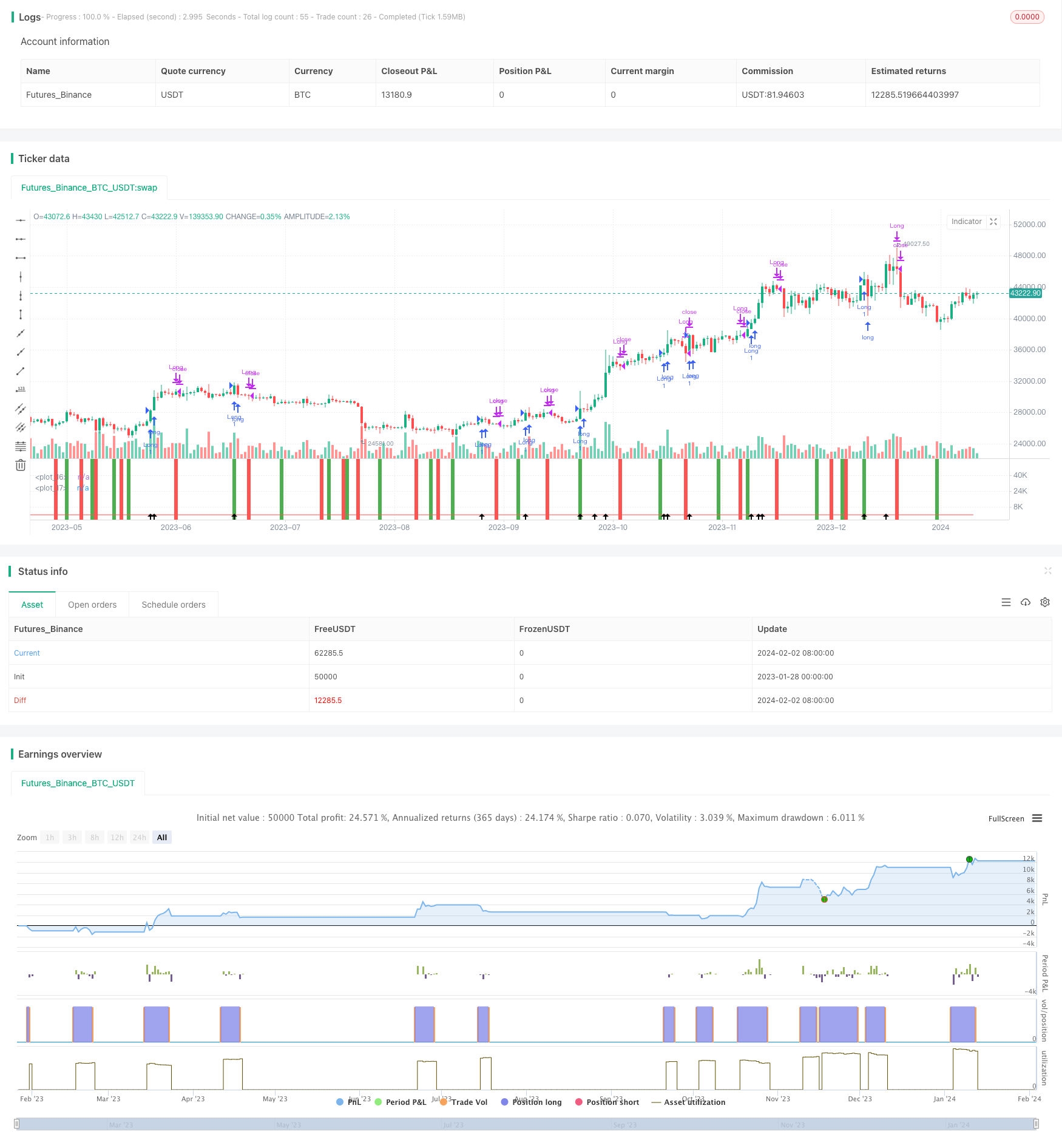
概述
该策略融合了Renko图和相对活力指数(RVI)两个指标,目标是捕捉市场主要趋势的大部分行情。适用于比特币、恒指等主流品种。
策略原理
策略使用9期ATR构建Renko砖,当收盘价格超过上一Renko砖高点时构建新砖,颜色为绿色;当收盘价格低于上一Renko砖低点时构建新砖,颜色为红色。结合RVI指标判定趋势方向。
RVI指标用于判断多头力量和空头力量的相对强度。RVI数值在0-1之间波动,高于0.5代表多头力量强于空头;低于0.5代表空头力量强于多头。当RVI上穿其平滑移动平均线时,代表空头力量减弱,多头力量增强,给出做多信号;当RVI下穿其平滑移动平均线时,代表多头力量减弱,空头力量增强,给出做空信号。
综合Renko砖方向和RVI指标的做多做空信号,进入相应的多头或空头仓位。
策略优势
- Renko砖隔离正常的市场波动,只关注更大幅度的价格变动,避免被套。
- RVI指标判断趋势发生反转的时机,进一步锁定交易信号。
- 结合两种指标进行过滤,可有效抓住市场主要趋势,过滤掉部分噪音。
风险分析
- Renko砖的大小直接影响交易频率,砖太大会错过机会,砖太小则会增加交易频率和手续费。
- RVI指标参数设置不当也会导致错过信号或增大假信号。
- 双重指标过滤会错过一定信号,无法抓住全部行情。
优化方向
- 动态优化Renko砖大小,让其自适应市场波动率。
- 优化RVI指标参数,寻找最佳平衡点。
- 尝试不同品种和周期参数组合,评估稳定性。
总结
该策略综合了两种不同类型指标的优点,目标是抓住市场主流趋势。通过对Renko和RVI参数的优化,可以获得更高的稳定性。但任何模型都无法完美,错过一定信号在所难免,关键是要把握主要方向。使用者需要清楚评估自身的风险偏好,选择适合自己的品种和参数。
策略源码
/*backtest
start: 2023-01-28 00:00:00
end: 2024-02-03 00:00:00
period: 1d
basePeriod: 1h
exchanges: [{"eid":"Futures_Binance","currency":"BTC_USDT"}]
*/
//@version=3
strategy("Lancelot RR Strategy", overlay=false)
p=9
CO=close-open
HL=high-low
value1 = (CO + 2*CO[1] + 2*CO[2] + CO[3])/6
value2 = (HL + 2*HL[1] + 2*HL[2] + HL[3])/6
num=sum(value1,p)
denom=sum(value2,p)
RVI=denom!=0?num/denom:0
RVIsig=(RVI+ 2*RVI[1] + 2*RVI[2] + RVI[3])/6
rvicloselongcondition = crossunder(RVI, RVIsig)
rvicloseshortcondition = crossover(RVI, RVIsig)
plot(RVI,color=green,style=line,linewidth=1)
plot(RVIsig,color=red,style=line,linewidth=1)
bgcolor(rvicloseshortcondition ? green : na, transp = 75)
bgcolor(rvicloselongcondition ? red : na, transp = 75)
///Renko///
TF = input(title='TimeFrame', defval="D")
ATRlength = input(title="ATR length", defval=9, minval=2, maxval=100)
SMAlength = input(title="SMA length", defval=5, minval=2, maxval=100)
SMACurTFlength = input(title="SMA CurTF length", defval=20, minval=2, maxval=100)
HIGH = request.security(syminfo.tickerid, TF, high)
LOW = request.security(syminfo.tickerid, TF, low)
CLOSE = request.security(syminfo.tickerid, TF, close)
ATR = request.security(syminfo.tickerid, TF, atr(ATRlength))
SMA = request.security(syminfo.tickerid, TF, sma(close, SMAlength))
SMACurTF = sma(close, SMACurTFlength)
RENKOUP = na
RENKODN = na
H = na
COLOR = na
BUY = na
SELL = na
UP = na
DN = na
CHANGE = na
RENKOUP := na(RENKOUP[1]) ? ((HIGH+LOW)/2)+(ATR/2) : RENKOUP[1]
RENKODN := na(RENKOUP[1]) ? ((HIGH+LOW)/2)-(ATR/2) : RENKODN[1]
H := na(RENKOUP[1]) or na(RENKODN[1]) ? RENKOUP-RENKODN : RENKOUP[1]-RENKODN[1]
COLOR := na(COLOR[1]) ? white : COLOR[1]
BUY := na(BUY[1]) ? 0 : BUY[1]
SELL := na(SELL[1]) ? 0 : SELL[1]
UP := false
DN := false
CHANGE := false
if(not CHANGE and close >= RENKOUP[1]+H*3)
CHANGE := true
UP := true
RENKOUP := RENKOUP[1]+ATR*3
RENKODN := RENKOUP[1]+ATR*2
COLOR := lime
SELL := 0
BUY := BUY+3
if(not CHANGE and close >= RENKOUP[1]+H*2)
CHANGE := true
UP := true
RENKOUP := RENKOUP[1]+ATR*2
RENKODN := RENKOUP[1]+ATR
COLOR := lime
SELL := 0
BUY := BUY+2
if(not CHANGE and close >= RENKOUP[1]+H)
CHANGE := true
UP := true
RENKOUP := RENKOUP[1]+ATR
RENKODN := RENKOUP[1]
COLOR := lime
SELL := 0
BUY := BUY+1
if(not CHANGE and close <= RENKODN[1]-H*3)
CHANGE := true
DN := true
RENKODN := RENKODN[1]-ATR*3
RENKOUP := RENKODN[1]-ATR*2
COLOR := red
BUY := 0
SELL := SELL+3
if(not CHANGE and close <= RENKODN[1]-H*2)
CHANGE := true
DN := true
RENKODN := RENKODN[1]-ATR*2
RENKOUP := RENKODN[1]-ATR
COLOR := red
BUY := 0
SELL := SELL+2
if(not CHANGE and close <= RENKODN[1]-H)
CHANGE := true
DN := true
RENKODN := RENKODN[1]-ATR
RENKOUP := RENKODN[1]
COLOR := red
BUY := 0
SELL := SELL+1
plotshape(UP, style=shape.arrowup, location=location.bottom, size=size.normal)
renkolongcondition = UP
renkoshortcondition = DN
///Long Entry///
longcondition = UP
if (longcondition)
strategy.entry("Long", strategy.long)
///Long exit///
closeconditionlong = rvicloselongcondition
if (closeconditionlong)
strategy.close("Long")